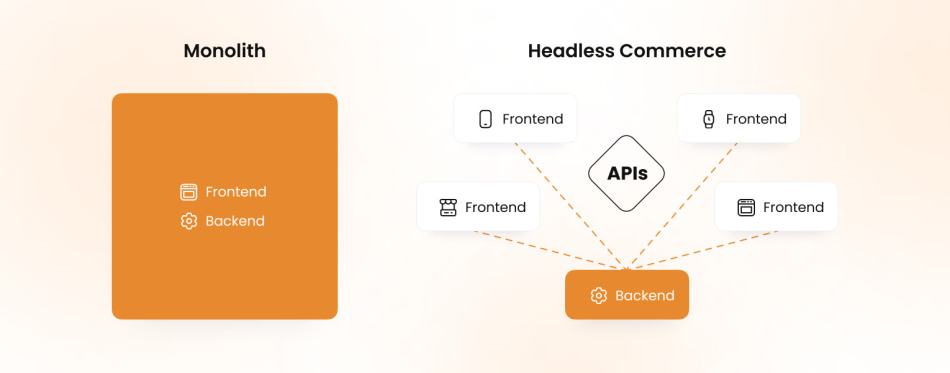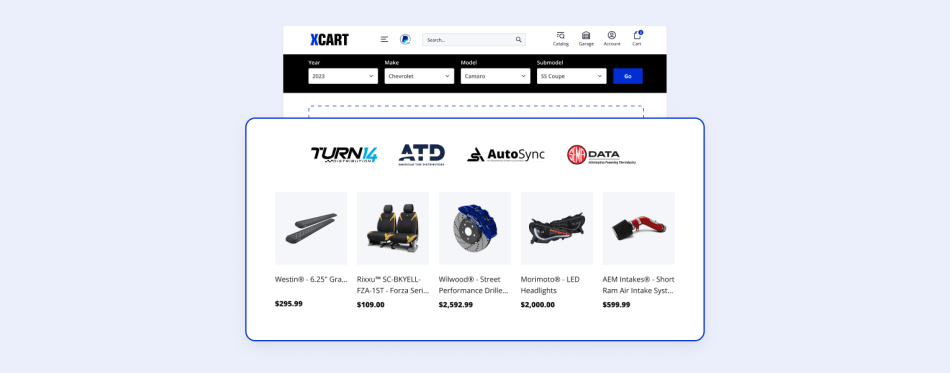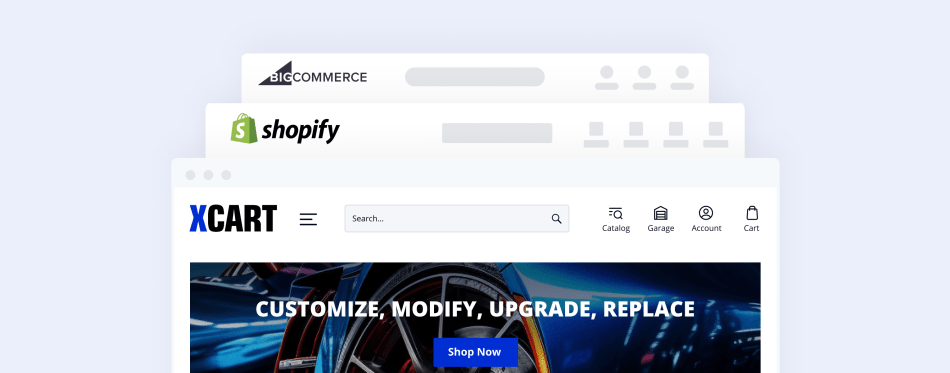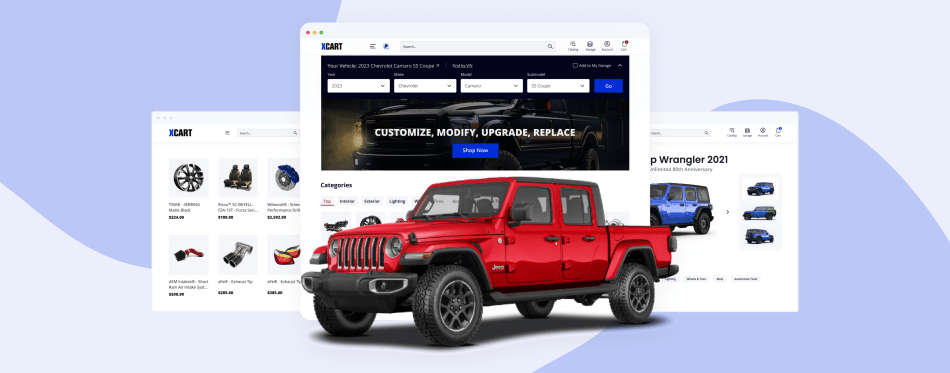How a Headless eCommerce Platform Helps Future-Proof Your Business: A Definitive Guide
Today eCommerce has gone far beyond just selling goods online. Due to the new buyer attitude towards the shopping experience, even a fantastic product may not be enough for successful sales until you provide smooth digital experiences and personalized approach at each stage of your customer journey.
While these goals are achievable with traditional eCommerce platforms, such solutions do not always offer quick and affordable ways to stay ahead of the technology curve while meeting customer expectations. This is where headless commerce pivots the online retail industry, providing a more cost-efficient and effective way to enable digital agility.
In this article, we break down what headless commerce is, explore why composable solutions are now gaining momentum, and unveil their main benefits over traditional eCommerce platforms.
I. What Is Headless eCommerce?
Unlike traditional eCommerce platforms where the frontend and backend are tightly bound, (which limits customization opportunities and design flexibility), headless eCommerce solutions separate an eCommerce website’s interface from the backend infrastructure.

With the headless approach, businesses can create and update customer-facing apps using the technology stack of their choice and without impacting the website’s backend processes.
Simply put, headless eCommerce solutions enable retailers to build highly flexible online stores that promise a solid competitive edge when it comes to new technology implementation and adjustable user experiences.
Traditional eCommerce vs. Headless eCommerce
| Traditional eCommerce | Headless eCommerce | |
| Architecture | The frontend and backend components are tightly coupled. | The frontend and backend processes are decoupled and operate independently. |
| Flexibility and customization | The out-of-the-box functionality aids in the easy launch. However, predefined user interface and template-based design limit customization and marketing options. | API-driven integrations allow for adding new features to the website with less time and effort. The frontend can be updated and adjusted without affecting the backend, enabling seamless design changes, and giving businesses more room for creativity. |
| Omnichannel presence | Each channel requires separate development and maintenance efforts. For a consistent user experience across channels, customization is required. | The backend API can support various frontend applications, ensuring seamless experiences across multiple devices and channels. |
| Website performance and speed | Due to the monolithic architecture, any backend or frontend changes can impact the overall website performance. | Frontend and backend can be optimized independently, allowing faster loading times and smoother user experiences. |
| Development and maintenance | With traditional eCommerce platforms, developers are restricted to a single technology stack and framework, where the frontend and backend are interdependent. This can limit the ability to mix and match new tools and services. | With headless solutions, developers can choose the most appropriate technology for each layer, leveraging the latest tools and frameworks. This translates into faster development cycles and improved developer productivity. |
II. Top 12 Benefits of Headless Commerce
According to the State of Commerce report by Salesforce, 80% of online businesses are planning to implement the headless architecture within two years, and not for nothing. Let’s take a closer look at the host of new opportunities that headless solutions open up in front of online retailers and their developer teams.
1. Storefront Adaptability
Headless architecture provides greater flexibility in UX design and customization. In other words, the front-end experiences can adapt to specific needs without the limitations of the backend system.
2. Flexibility for Developers
Headless commerce brings numerous advantages, particularly in terms of flexibility for frontend developers. This approach empowers businesses to select the ideal eCommerce platform to power their online store, while simultaneously having the freedom to work with their preferred frontend solution, whether it’s a CMS, a DXP, a PWA, or a custom-built option. As a result, developers can leverage technologies and programming languages that align with their expertise, streamlining their workflows and enhancing overall efficiency.
3. Scalability
Headless eCommerce platforms can handle high volumes of traffic and transactions, ensuring smooth operation even during peak periods. By separating the frontend and backend, businesses can scale each component independently based on demand. The websites that scale effectively can handle traffic spikes without affecting performance.
4. Omnichannel Capabilities
With headless commerce systems, businesses can deliver consistent and personalized shopping experiences across various touchpoints. By using APIs, you can integrate your online store with other systems, such as web and mobile apps, voice assistants, IoT devices, and social media platforms. In this case, API allows for a seamless data sync and a unified view of customer interactions.
5. Enhanced SEO and Website Performance
According to Gitnux, businesses utilizing headless commerce solutions report a 20% decrease in website load times. Improved website performance ensures decreased bounce rates, longer time-on-page, and higher conversion rates and has a positive impact on SEO results.
6. Outstanding Shopping Experiences
With a headless approach, you can create an online storefront that embodies your brand, captivates your audience, and creates a positive long-lasting impression.
7. Agile Technology Adoption
With API-driven solutions, you can easily integrate your web store with third-party payment gateways, inventory management systems, and marketing automation tools of your choice. Furthermore, headless platforms offer the ability to adopt emerging technologies and stay ahead of the curve, ensuring long-term relevance and the ability to adapt to changing market trends.
8. Faster Development
Separation of frontend and backend provides independent development, allowing teams to work simultaneously and speeding up the development process.
9. Effective Marketing
Headless architecture enables businesses to experiment with various marketing tools, merchandising campaigns, and content variations. It also enables online retailers to streamline their marketing efforts across various platforms and devices by handling campaigns from a single place.
10. Content-First Approach
Headless eCommerce platforms prioritize composable content management, facilitating creating and managing dynamic and multimedia-rich content across various channels. With this approach to content creation, you can break down elements into small building blocks, making them easier to manage and modify without being tied to a particular format.
11. Faster Time-to-Market for Features
Headless commerce allows businesses to iterate and launch new features and deliver interactive experiences more rapidly. With separate frontend and backend development, updates happen independently, reducing limitations and enabling faster deployment.
12. Painless Migration
Headless commerce offers a streamlined process for business owners looking to migrate from one eCommerce platform to another. With headless solutions, replatforming is relatively straightforward, thanks to multiple third-party providers available to handle technical processes independently without disrupting the customer experience.
Going headless is meant to future-proof your business by incorporating beneficial features and services to avoid going through a much more costly migration process. Simply put, it’s much more reasonable to invest into headless migration than to build a completely new website later on.
III. Is Headless eСommerce Right for YOUR Online Business?
In this article, we’ve mentioned a lot of benefits that API-driven eCommerce solutions promise to online businesses, so you might have thought that headless is a perfect fit for any eCommerce business. However, the truth is that it is not.
If you are satisfied with how your online store operates on a traditional eCommerce platform, it may not be worth the costs and resources to tap into headless.
Taking a new approach may be the right decision if you are struggling with feature limitations, poor website performance, drops in customer loyalty, or functionality gaps.
Main Indicators That Your Business Needs a Headless Solution
- Lack of personalized and interactive buyer experiences. To gain control over the presentation layer, you need a custom frontend solution allowing you to optimize the user interface based on specific sales channels, customer segments and demographics across various touchpoints.
- Demand for innovation. Your business operates in a rapidly changing industry where agility and flexibility are essential, urging you to quickly launch new features to adapt to market trends. You need the flexibility to experiment with different frontend technologies and frameworks, allowing for faster innovation to outgrow competition.
- Need for consistency across various channels. If you have multiple websites nationwide or across the globe you’d like to sync all the data and manage it from a single backend system. This also rings true for business models that involve multiple third-party integrations, such as partnerships with dropshippers, warehousing companies, and data feed networks, to name a few.
- Inefficient performance. Your store experiences high traffic volumes and requires scalable infrastructure to handle spikes in demand without sacrificing performance.
- Coupling content and commerce websites. Headless approach allows companies with an existing Content Management System (CMS) to add commerce functionality to their corporate websites and start selling online.
- Large catalog concerns. Suppose you have a complex product catalog with different variations, options, and bundles. In that case, you need advanced product management and interface capabilities to comprehensively present all the product details to your customers and ensure intuitive website navigation.
IV. What Do I Need to Adopt a Headless Approach Successfully?
For eCommerce businesses, a headless solution can solve such issues as unstable website performance, functionality gaps, and lack of personalized shopper experience, to name a few. However, before adopting an entirely new approach to online store creation, one should weigh the benefits against the additional costs and the complexity of building a headless eCommerce system.
The decision in favor of headless eCommerce should be based on your specific business needs, available resources, and the technology stack that aligns with your long-term goals.
Trusted eCommerce Solution
Any successful eCommerce business is backed with powerful technology capable of creating outstanding, memorable user experiences. This is where headless commerce provides a more affordable option than tailoring an eCommerce platform from scratch. Instead, you can acquire a suitable solution from a software provider who will meet industry regulations, guarantee backend security, and even manage hosting and payment processing.
Robust Technology Infrastructure
Headless architecture needs a solid technological foundation to ensure all the operations will run smoothly. This entails reliable servers, databases, and network infrastructure that can effectively handle the evolving needs of your business as it expands.
Skilled Development Team
Since headless commerce relies on APIs (Application Programming Interfaces) to connect the frontend and backend systems, companies must have a skilled development team to implement API integrations effectively and maintain the headless eCommerce ecosystem. This involves hiring the front-end developers experienced in working with headless frameworks and backend specialists proficient in building APIs and integrating systems.
Analytics and Reporting Tools
Companies should have access to analytics and reporting tools to measure and optimize performance effectively. The required resources may vary based on the project’s complexity and the unique needs of your business.
Generally, businesses need tools that help monitor website traffic, customer behavior, conversion rates, and other key metrics to make data-driven decisions and drive continuous improvements. Partnering with experienced data analytics service providers can also help ensure a successful headless eCommerce setup.
V. Challenges of Headless eCommerce
Despite all its benefits the headless approach may still pose some challenges for online retail companies, depending on their business model, expertise, and available resources.
Complexity of headless ecosystem. Unlimited options to customize your online store can be a double-edged sword. Complexity may arise when it comes to collecting data from a host of connected solutions, interpreting it, and putting those interpretations into practice. This is where you’ll need powerful analytics tools to sync and manage your data effectively.
Third-party app maintenance. Some popular headless solutions provide their API for building apps to their developer-partners which means the functionality in your eCommerce store will virtually be built by different software providers.
The issues may arise when multiple third-party integrations created by different developer teams start to require investments in maintenance. This is a good point to consider in advance, otherwise updates may cost you a fortune in the long run.
Choosing the right Content Management System (CMS). With the separation of the frontend presentation layer from the backend, companies require a versatile CMS to control and distribute content across various channels and touchpoints. When choosing a suitable headless CMS, it is crucial to consider its user-friendliness, efficiency, scalability, integrations, and adaptability.
Additionally, it is essential to choose a solution that provides reliable APIs, comprehensive documentation, a supportive community, and, most importantly, compatibility with your technology stack.
Customization concerns. When choosing a headless solution, it’s crucial to pick the one that will ensure the maximum control over your project and the functionality you are building with the provided API. The opportunity to customize API gives businesses with specific requirements more options to build a unique solution to their vision.
Another concern is that customizations require an in-house development service, which most platforms just don’t provide, urging business owners to hire third-party developers.
VI. X-Cart and Headless eCommerce
X-Cart is an eCommerce platform with a host of advanced API-driven integrations. Unlike most popular headless solutions, we provide the best of the two worlds by offering businesses robust APIs backed by the in-house professional developer team.
With this client-centric API-driven approach, X-Cart allows for building a flexible and highly scalable eCommerce solution that empowers businesses to deliver interactive and engaging experiences across multiple channels.
Due to the adaptable infrastructure, X-Cart facilitates smooth integrations with diverse frontend frameworks. In addition to offering developers the freedom to use their preferred tools, we’ve created our own web application, Frontapp, built with advanced frontend technologies such as Next.js, TypeScript, and Tailwind CSS.
At X-Cart, we’ve gone beyond just building the Frontend API. Our Frontapp can be a solid starting point for developing your unique storefront. You may use it as a template or an example if you prefer to start from the ground up. The great thing about having such a reference is that you don’t have to code basic things from scratch. Instead, you can use the pre-coded pieces and add features and design specific to your business into an operational base.
We’re also working to improve the future versions of the Frontapp so businesses can use it without any significant modifications. By constantly testing our Storefront API through Frontapp, we get valuable insights and better understand frontend developers’ needs. This firsthand experience directly contributes to our API’s continuous refinement and enhancement, resulting in an even better developer experience.
For online retailers, we’ve managed to combine the prebuilt feature-rich native integrations with limitless customization options allowing businesses to tailor unique and versatile API-based solutions that would answer their goals and specifics.
Get the Desired Flexibility with X-Cart
Build an adaptable eCommerce website powered by robust APIs and cutting-edge frontend technologies.
FAQs
A headless eCommerce website operates with separate frontend and backend components that constantly communicate through application programming interfaces (APIs). Developers use APIs to send data and experiences across customer touchpoints. APIs take signals from the frontend user interface, direct them to the backend, and then return with new information, translating it into a frontend experience.
In headless CMS platforms, the backend content management is separated from the presentation layer. These platforms allow businesses to manage content and create customized frontend experiences while leveraging APIs to connect with backend systems.
With the backend side and presentation layer being separated, frontend developers can choose a modern stack of technologies to build a custom interface that delivers flexible, personalized user experiences corresponding to the latest customer demands.
Headless eCommerce platforms provide a higher level of flexibility, opening up more opportunities for businesses to seamlessly add new functionality when they see fit via API integrations. With the smooth inner processes ensured by robust API connections, businesses can achieve and maintain a solid competitive advantage in the market.
Headless solutions allow businesses to achieve better content discoverability and website speed results. Although SEO strategies are likely to be the same regardless of whether you use headless commerce or a monolithic system, in the case of a headless solution, you’ll be able to execute those strategies without unnecessary technical blockers.
About the author









